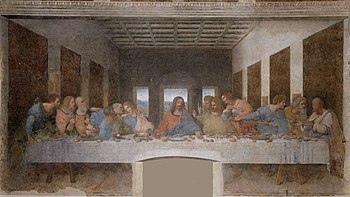As in most years, our church had a form
of a Last Supper re-enactment as part of the Maundy Thursday service. Tonight's
version featured the setting of Leonardo da Vinci's painting, The Last
Supper and featured a brief history of the famous painting in the beginning
narrative. It was well done with various men offering a short soliloquy, followed
by a reflection by one of the pastors and then Holy Communion.
Several years ago, I had done a lengthy paper for a Western Civilization class on this painting. I found the story fascinating and Leonardo even more fascinating. The following are excerpts from that paper and I cited the sources at the bottom. Since this is for fun I refuse to use footnotes!
Leonardo Da Vinci painted the original
fresco on one of the walls of the Dominican monastery of Santa Maria delle
Grazie in Milan. Matteo Bandello, who was a novice monk at the time, recorded
that Da Vinci would sometimes work on the fresco from sunrise to sunset without
stopping and at other times would spend hours a day standing in front of the work
with his arms folded across his chest staring at the figures on the wall.
Bandello also reports that on one occasion he saw Da Vinci leave another job
site and walk quickly across the village in the hot sun to the monastery only
to pick up a paintbrush to paint one or two strokes.
Da Vinci based the figures of the Last Supper on real people, people that
he encountered and people that he just saw in passing. Detailed sketches of
faces and body features, such as hands and studies of the folds of cloth for Peter’s
sleeve are found in Leonardo’s sketchbooks. He also made lists of possible
reactions of the disciples, such as twisting the fingers of a hand or turning
to look at a companion. Leonardo also broke with a tradition from the Middle
Ages in which the disciples are shown as being stiffly linear in their
arrangement at the table.
Work began on the fresco in 1495 and
concluded sometime after 1497 (a fire at the monastery destroyed records so the
dates are based on other documents). Sadly, within a few years the paint had
already begun to flake and crumble. Leonardo had used a dry-wall painting
technique that was appropriate; however, it was his experimentation with mixing
oil and tempera for the painting on the dry plaster that was the cause of the
subsequent flaking off of the paint. Working on dry plaster enabled him to work
slower and to be able to re-paint but resulted in the paint eventually flaking
off the surface. Moisture and dampness in the refectory also contributed to the
incompatibility of the paint and prepared wall surface.
Restorations have taken place from time
to time. Recent efforts have revealed many hidden details such as a hand drawn
sketch done on the prepared wall before the final preparatory coat of gesso and
imprimatura. Several authentic copies of the fresco have survived and have been
invaluable in restoration efforts. The fresco is so fragile that extensive work
is not practical. Today’s viewer sees only about 20% of the original version of
the Last Supper and while it appears
ghost-like on the wall of the ancient monastery viewers still witness the
expressions and gestures of the apostles and the details of the table set for
the meal that were painted over 500 years ago.
Sources Cited
Bruce Cole, Masaccio and the Art of Early Renaissance Florence(Bloomington:
Indiana University Press, 1979) 208-209
Stefan Klein, Leonardo’s Legacy (Cambridge:Da Capo Press, 2010) 1-3
CharlesNicholl, Leonardo Da Vince Flights of the Mind (New York: Penguin Group
Inc., 2004) 292-293
Jackson J. Spielvogel, Western Civilization: A Brief History Volume
1: to 1715 (Boston: Wadsworth, 2011) 255-256
Giorgio Vassari, Artists of the Renaissance (New York:Viking Press, 1978) 179


.jpg)


.jpg)
.jpg)
.jpg)




